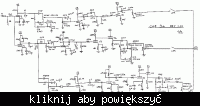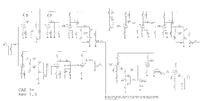Hello. (I hope I chose the right section on the forum)
I am going to assemble a guitar preamplifier, namely the little known (unfortunately) CAE3 + Se - Custom Audio Electronics (Bob Bradshaw). I was looking for schematics on the internet and it is quite poor, here's what I found:
Scheme1:
http://www.settoflames.com/CAE%203_SE.bmp
Scheme2:


I noticed that the diagrams differ to a large extent from each other - an additional seventh lamp (the original has 7). However, the diagram with 6 tubes is clearer and more understandable, what will be the difference in sound? And what about the voltage supplying the lamps? The diagrams are not perfect, so if someone would have something better, I would be very grateful. This preamp is my little dream, I will add that it is currently played by Steve Lukather himself.
The diagrams should be pasted using the "Add image" option - please correct.
/ presidentwal /.
I am going to assemble a guitar preamplifier, namely the little known (unfortunately) CAE3 + Se - Custom Audio Electronics (Bob Bradshaw). I was looking for schematics on the internet and it is quite poor, here's what I found:
Scheme1:
http://www.settoflames.com/CAE%203_SE.bmp
Scheme2:


I noticed that the diagrams differ to a large extent from each other - an additional seventh lamp (the original has 7). However, the diagram with 6 tubes is clearer and more understandable, what will be the difference in sound? And what about the voltage supplying the lamps? The diagrams are not perfect, so if someone would have something better, I would be very grateful. This preamp is my little dream, I will add that it is currently played by Steve Lukather himself.
The diagrams should be pasted using the "Add image" option - please correct.
/ presidentwal /.




